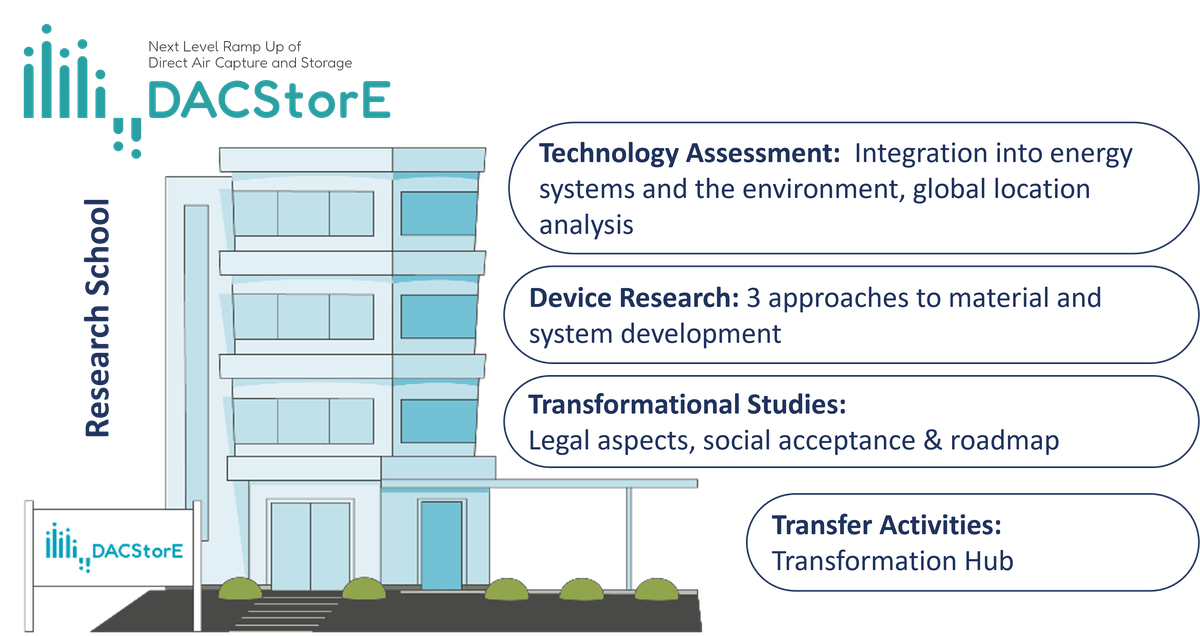Next Level Ramp Up of Direct Air Carbon Capture and Storage
news
Wenn Sie über die DACStorE-Veranstaltungen benachrichtigt werden möchten, senden Sie bitte eine E-Mail an dacstore-info(at)fz-juelich.de mit dem Betreff ‚Mailverteiler‘ oder kontaktieren Sie uns gerne über unser LinkedIn-Profil.
Über DACSTORE
Der jüngste Bericht des Weltklimarats (Intergovernmental Panel on Climate Change, IPCC) zeigt, dass negative Emissionspfade unvermeidlich sind, um das 2-Grad-Ziel zu erreichen. Vertiefte Transformationsszenarien von Mitgliedern des DACStorE Konsortiums zeigen, dass Landnutzungsänderungen und Aufforstung allein das Problem nicht lösen werden. Stattdessen sind großmaßstäbliche negative Emissionstechnologien erforderlich, von denen Direct Air Carbon Capture and Storage (DACCS) vielversprechend erscheint. Ziel des Projekts DACStorE ist es daher, einen großen und nachhaltigen Scale-up der DACCS-Technologie vorzubereiten. Sechs Helmholtz-Zentren und die TU Berlin erforschen technische Lösungen für die Abscheidung von CO2 aus der Umgebungsluft und dessen Speicherung in geologischen Formationen.

Weitere Informationen zu
Unser Statement zur Chancengerechtigkeit, Diversität und Inklusion:
Im DACStorE-Projekt und in der Graduiertenschule NETs@Helmholtz engagieren wir uns für eine diverse, chancengerechte und inklusive Umgebung für Forschung und Bildung, in der jede Person wertgeschätzt, respektiert und befähigt wird, erfolgreich zu sein.
Wir fördern wir eine offene und innovative wissenschaftliche Gemeinschaft indem wir Nachwuchsforschende aktiv stärken, Vereinbarkeit von Familie und Forschung unterstützen, und alle Projektmitarbeitende in Diversität, Inklusion und Antidiskriminierung schulen. So schaffen wir die Grundlage für kreative und nachhaltige Lösungen, die wissenschaftliche Exzellenz vorantreiben und zur Erreichung der Klimaneutralität beitragen – zum Nutzen aller Teile einer vielfältigen Gesellschaft.
Entdecken Sie unsere aktuellen Projekte der Research School NETs@Helmholtz
Information zur Projektförderung
Die Helmholtz-Gemeinschaft fördert das Projekt DACStorE innerhalb der Forschungskampagne „Helmholtz Sustainability Challenge“ (Förderkennzeichen: KA2-HSC-12, Förderzeitraum: September 2022 – August 2027). Den Rahmen dafür bildet der erste Call des Impuls- und Vernetzungsfonds. Hier finden Sie weitere Informationen zur Forschungsförderung (https://www.helmholtz.de/en/about-us/structure-and-governance/initiating-and-networking/).


















